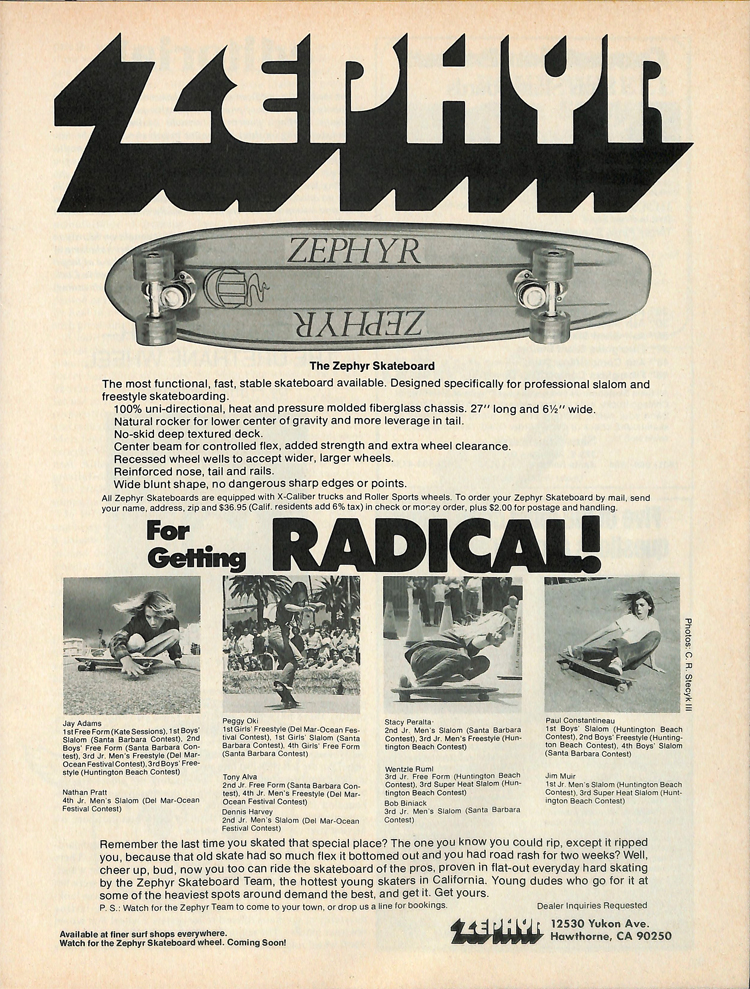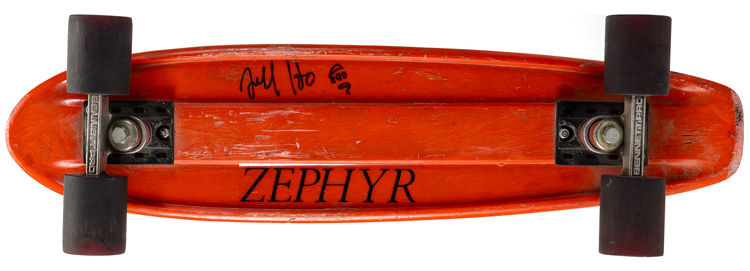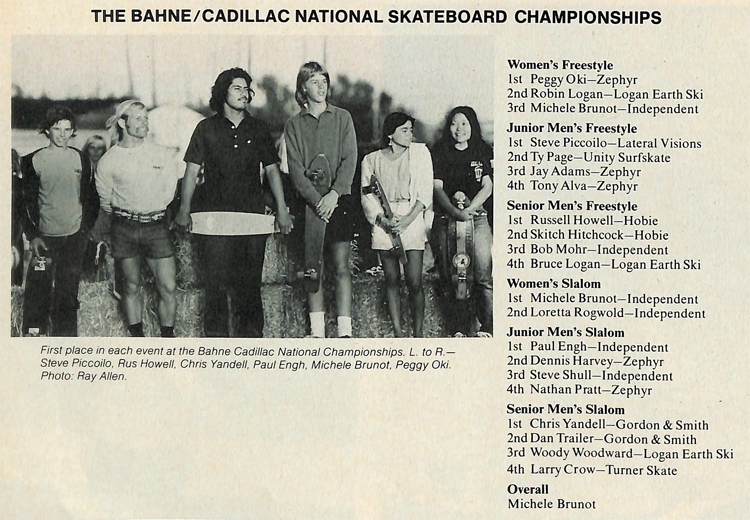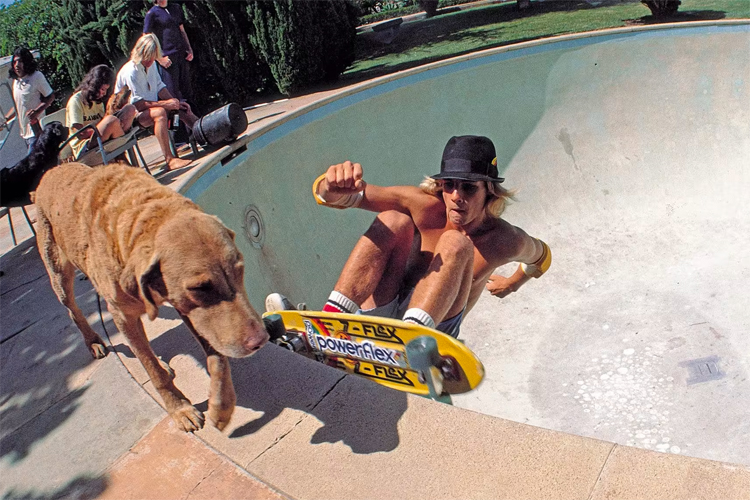The Z-Boys, also known as the Zephyr Competition Team, were a group of surfers turned skateboarders formed in Venice and Santa Monica, California, in the mid-1970s.
The story of the Z-Boys involves three key individuals - Craig Stecyk, Skip Engblom, and Jeff Ho.
In the winter of 1968, Engblom and Stecyk were hanging out when they spotted Jeff in his truck.
Ho was running his own Jeff Ho Surfboards.
Craig suggested Skip team up with Jeff, and soon after, they were a trio renting space on Granville Avenue for $300 a month.
"Jeff was incredibly ultra hip," recalls Stacy Peralta in Michael Brooke's book "The Concrete Wave."
"He had multicolored glasses, drove a 4x4 truck back in the 1970s when they weren't popular, and was an amazing surfer. He was what you'd call 'Superfly.'"
The young businessmen needed a name for their new venture.
"I chose the name Zephyr because I wanted to be the last name in the phone book," said Skip Englebom, who was already an experienced skater.
The newly-established Jeff Ho Surfboards and Zephyr Productions (JHS & ZP) was now a surf shop and surfboard shaping facility with its headquarters in the heart of Santa Monica.
The business was growing fast.
In 1971, Ho, Engblom, and Stecyk wanted a surf team to represent their brand in competitions.
Two years later, they had already recruited their first star.
Nathan Pratt, 14, had learned to shape surfboards at JHS & ZP and was soon surfing alongside and wearing the same shirts as Stacy Peralta, Jay Adams, Tony Alva, and other more experienced wave riders.
They all lived in Santa Monica's "Dogtown" and surfed The Cove, a post-industrial surf spot located at Pacific Ocean Park (POP), an old abandoned pier.
"We would ride our bikes at 4 am to go surfing and had to be careful not to be beaten up by roving gangs," Stacy Peralta once revealed.
But when Southern California lineups were flat and waveless, a new sport was picking up on the nearby tarmac - skateboarding.

Who Created and Who Were the Z-Boys?
The year was 1973.
"Tony Alva and Jay Adams approached Skip and showed him the new Cadillac urethane wheels. Skip realized how good the wheels were and started buying them for the shop," explains Brooke.
"Jay's stepfather, Kent Sherwood, owned a fiberglass shop, and a decision was made to have Kent and his partner, Dave Sweet, start manufacturing skateboards for Zephyr."
Ho and Engblom saw the four-wheel board revolution exploding in front of their eyes and quickly formed a skate squad sponsored by JHS & ZP.
They also knew they could do something better than the Bahne skate decks. So, after a failed fragile prototype, a new rocker design changed the paradigm.
Now, they only needed a name for their troupe and talented surfer-skaters.
The founding members of the Zephyr Competition Team were Allen Sarlo, Chris Cahill, Jay Adams, Nathan Pratt, Stacy Peralta, and Tony Alva.
Shortly after, the original Z-Boys crew consisted of the following 12 skaters:
- Allen Sarlo
- Bob Biniak
- Chris Cahill
- Jay Adams
- Jim Muir
- Nathan Pratt
- Paul Constantineau
- Peggy Oki
- Shogo Kubo
- Stacy Peralta
- Tony Alva
- Wentzle Ruml IV
Additional members joining the Zephyr Skate Team are:
- Cris Dawson
- Dennis Harney
- Donnie Oldham
- Jose Galan
- Paul Cullen
- Paul Hoffman
- Tommy Waller

Ride Everything
It was time to deliver.
The newly formed started practicing and improving their old-school tricks and maneuvers on the outskirts of four Santa Monica schools.
Those who witnessed the early Z-Boys days would notice that they were clearly porting wave riding into street riding.
In other words, the legendary California skate team was literally surfing the outdoor urban environments of their town and neighborhoods.
Everything was skateable, and they would even drag their hands against the ground as if they were stalling for the barrel.
Some of the most memorable skateboarding photos in the sport's history take us back to that post-"Skaterdater" golden period.
Craig Stecyk and his clinical eye for dramatic, intense, and highly expressive photos ended up in the iconic "Dogtown Articles" series published in Skateboarder Magazine.
"There would have been no Dogtown if it weren't for Stecyk," Jay Adams once stated.
Glen E. Friedman was another pivotal skate photographer of the 1970s. Later, he would partner with Stecyk and release the stunning book "DogTown: The Legend of the Z-Boys."

The First Real Test
The Z-Boys' first public appearance occurred at the 1975 Bahne/Cadillac National Skateboard Championships, commonly referred to as the Del Mar Nationals.
They knew what was at skate - it was the first major skateboarding contest in a decade.
Despite being criticized for their aggressive low-riding style by the older and more conservative skaters, the Zephyr Competition Team stormed the event.
The JHS & ZP squad and their punk rock attitude earned a spot on the podium of three of the six divisions.
Peggy Oki won the women's freestyle division, Jay Adams and Tony Alva finished third and fourth in the junior men's freestyle, and Dennis Harvey was runner-up in the junior men's slalom.
The Del Mar Nationals marks a turning point in the evolution of skateboarding and its multiple different disciplines.
"Our concept of freestyle was entirely different," Nathan Pratt explained in a June 1977 Skateboard Magazine interview.
"Nobody did handstands or wheelies or any of that kind of junk - it was performance style, not a trick style."
"We said we're going to skate our way, not their way. So we went into that contest and did full-out, high-performance, aggressive skating."
Craig B. Snyder, author of "A Secret History of the Ollie," notes that Jay Adams, "the most creative member of the Zephyr Skate Team," even pulled off a Bunny Hop in "a sequential, hyperkinetic burst during his freestyle routine."
Zephyr's executive approach toward competition also reflected the team's go-for-it attitude.
"I'd come up to the registration desk, hand over the stuff [entry forms and entrance fees], and say, 'we're the Zephyr team, and we're here to win,'" Skip later revealed.
Droughts, Pools, and Legacy
In 1976 and 1977, Southern California experienced a climate event that would result in the first and fourth driest years in Golden State's history.
As a result, water became - like waves - a scarce resource. It was time to close the tap and save water at all costs.
And backyard swimming pools were definitely not a priority. Actually, it was almost criminal to fill them with clean, fresh water.
All of a sudden, empty pools were an opportunity and a new playground for 1970s California skateboarders.
Moreover, they resembled the ocean waves, with their curved forms, smooth concrete, more or less steep slopes, and top-to-bottom walls.
Pools, also known in the skate world as "bowls," gave birth to aerial and vertical skateboarding.
The Z-Boys paved the way for a growing interest in skateboarding.
The team slowly disintegrated, with several members getting highly paid sponsorship deals from several skate companies.
By 1977, the most famous skateboarding team of all time dispersed and eventually broke up.
But their legacy is incommensurable and can be relived in the documentary "Dogtown and Z-Boys" and the movie "Lords of Dogtown."
The Z-Boys were skateboarding's first edgy countercultural movement and restless innovators. They were responsible for moving the sport from freestyle and slalom to vert in pipes and pools.
Zephyr was one of the most influential surf-and-skate manufacturers of the 1970s.
The Dogtown's myth and legend live.
